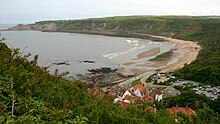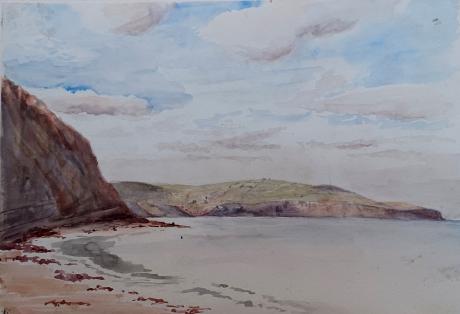signed with initials "LWT"
Tom and Laura Taylor and thence by descent
Runswick Bay is a bay in the Scarborough Borough of North Yorkshire, England. It is also the name of a village located on the western edge of the bay (although the village is sometimes shortened to Runswick on UK road signs). It is 5 miles (8 km) north of Whitby, and close to the villages of Ellerby and Hinderwell. It is a popular tourist attraction due to its picturesque cliffside village, stunning coastal walks, fossil hunting and Runswick Sands, a white sand beach. It is on the Cleveland Way national trail. Runswick Bay was chosen as Beach of the Year 2020 by The Sunday Times.

The original fishing village was almost completely destroyed by a landslide in 1682. Remarkably, there were no fatalities, as the village was alerted by two mourners at a wake. The village was rebuilt, slightly further to the south, perched on the side of cliffs.

The village ran its own lifeboat from 1866, until it was moved to the RNLI station at Staithes in 1978. The boathouse still remains, and has run its own volunteer rescue boat service since 1982.
In the late 1880s, Runswick Bay was the site of an art colony.
The Marquess of Normanby's Mulgrave Estate owns part of the land in the village which is also in the North Yorkshire Moors National Park.
The village is located within the Parish of Hinderwell, which at the 2011 census, had a population of 1,875 people.
On the north side of the bay is Cauldron Cliff, and the headland on the south side is known as Kettleness, site of alum mining from 1727 until the late 1800s. Around the edge of the bay is a white sand beach called Runswick Sands, and a series of caves. The largest cave on the bay, Hob Hole, was so named as it was believed to be the home of a 'Hob' (or Boggart) in local folklore. The bay is 1.2 miles (2 km) long. A seawall, made of large boulders, was completed in 1970. Like other parts of the Yorkshire Coast, the area suffers from a high degree of coastal erosion which has made it a popular location for fossil hunting.

A number of local streams drain into the bay across Runswick Sands; from West to East: Nettle Dale, Dunsley Dale, Calais Beck and Widgeytoft Gill.
Runswick Bay village covers an area of 620 hectares and has a peak seasonal population of 2,315, though permanent residence is low with a high degree of houses being holiday lets and second homes. It is split into two parts, the 'lower' red-roofed, cliff-side, former-fishing village, and Runswick Bank Top, a hamlet located adjacent to farmland overlooking the bay, built around the intersection of the roads leading to Ellerby and Hinderwell. The Bank Top village contains a camping and Caravan site, a hotel and modern housing developments. The two parts of the village are joined via a steep lane which is part of the Cleveland Way, with the beach located at the bottom of the lane.
The Lower village of Runswick Bay is densely packed with narrow winding streets and steep steps. It is largely inaccessible to traffic accessed only by a 1 in 4 gradient road. Key buildings include the old lifeboat station, and a thatched cottage which is a Grade II Listed building. There is a sailing club, a pub, one car park, holiday cottages to rent, public toilets and a beachside cafe. There are no disabled facilities and due to the uneven slopes access can be difficult
A £2.28 million pound award-winning coastal erosion protection scheme was completed in 2018 to protect the village for another 100 years
Laura Wilson Barker (6 March 1819 – 22 May 1905), was a composer, performer and artist, sometimes also referred to as Laura Barker, Laura W Taylor or "Mrs Tom Taylor".
She was born in Thirkleby, North Yorkshire, third daughter of a clergyman, the Rev. Thomas Barker. She studied privately with Cipriani Potter and became an accomplished pianist and violinist. As a young girl Barker performed with both Louis Spohr and Paganini. She began composing in the mid-1830s - her Seven Romances for voice and guitar were published in 1837. From around 1843 until 1855 she taught music at York School for the Blind. During this period some of her compositions - including a symphony in manuscript, on 19 April 1845 - were performed at York Choral Society concerts.
On 19 June 1855 she married the English dramatist, critic, biographer, public servant, and editor of Punch magazine Tom Taylor. Barker contributed music to at least one of her husband's plays, an overture and entr'acte to Joan of Arc (1871), and provided harmonisations as an appendix to his translation of Ballads and Songs of Brittany (1865).
Her other works include the cantata Enone (1850), the violin sonata A Country Walk (1860), theatre music for As You Like It, (April 1880), Songs of Youth (1884), string quartets, madrigals and solo songs. Her choral setting of Keats's A Prophecy, composed in 1850, was performed for the first time 49 years later at the Hovingham Festival in 1899. The composer was present.
Several of Barker's paintings hang at Smallhythe Place in Kent, Ellen Terry's house.
Barker lived with her husband and family at 84 Lavender Sweep, Battersea. There were two children: the artist John Wycliffe Taylor (1859–1925), and Laura Lucy Arnold Taylor (1863–1940). The Sunday musical soirees at the house attracted many well-known attendees, including Lewis Carroll, Charles Dickens, Henry Irving, Charles Reade, Alfred Tennyson, Ellen Terry and William Makepeace Thackeray.
Tom Taylor died suddenly at his home in 1880 at the age of 62. After his death, his widow retired to Porch House, Coleshill in Buckinghamshire, where she died on 22 May 1905, aged 86.

